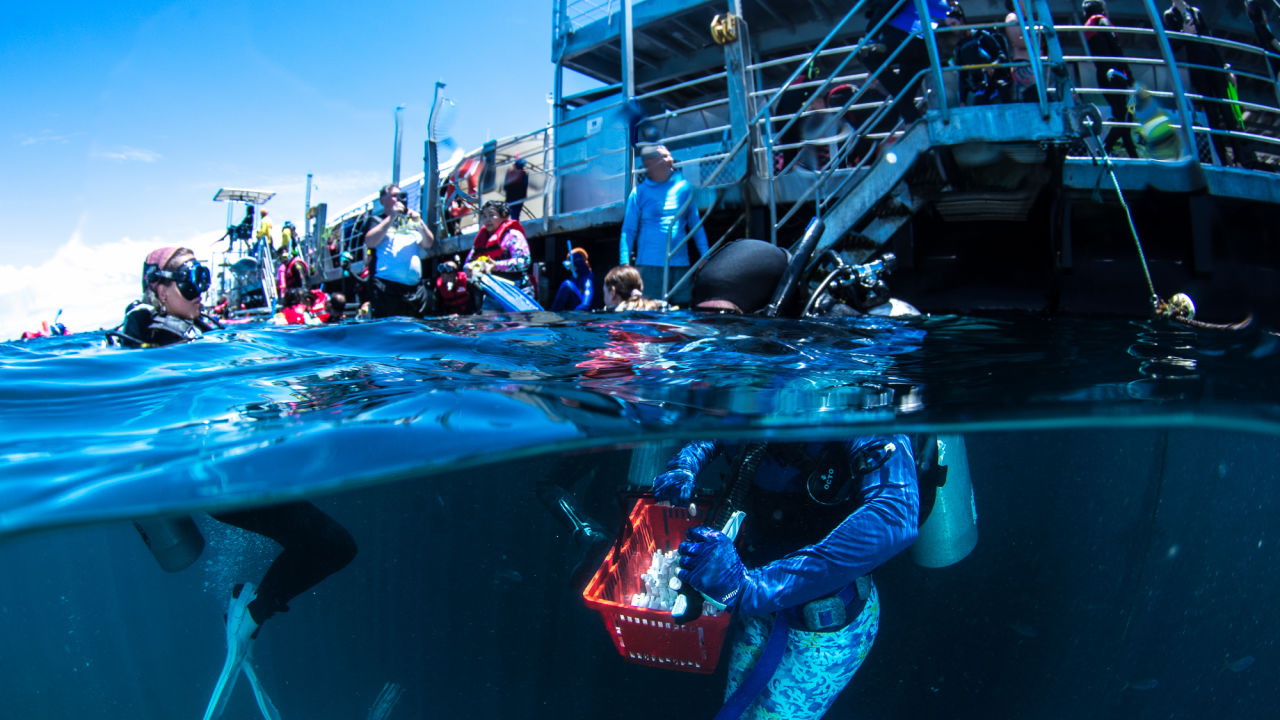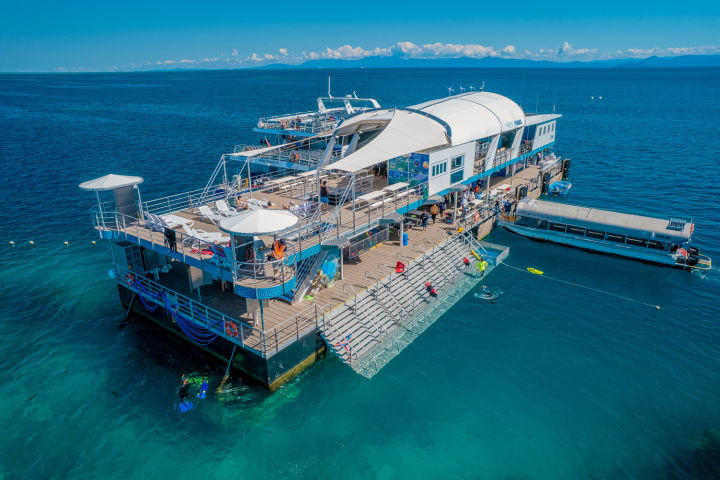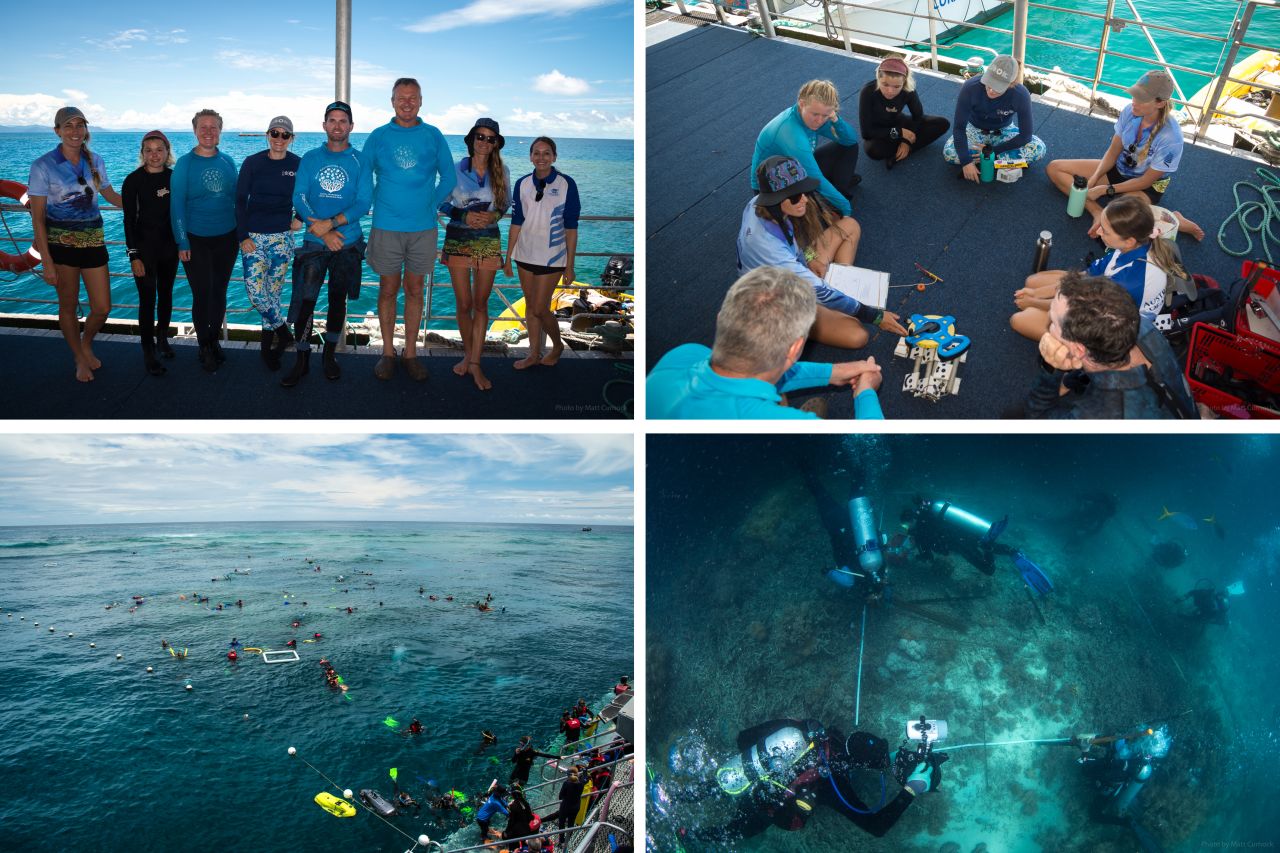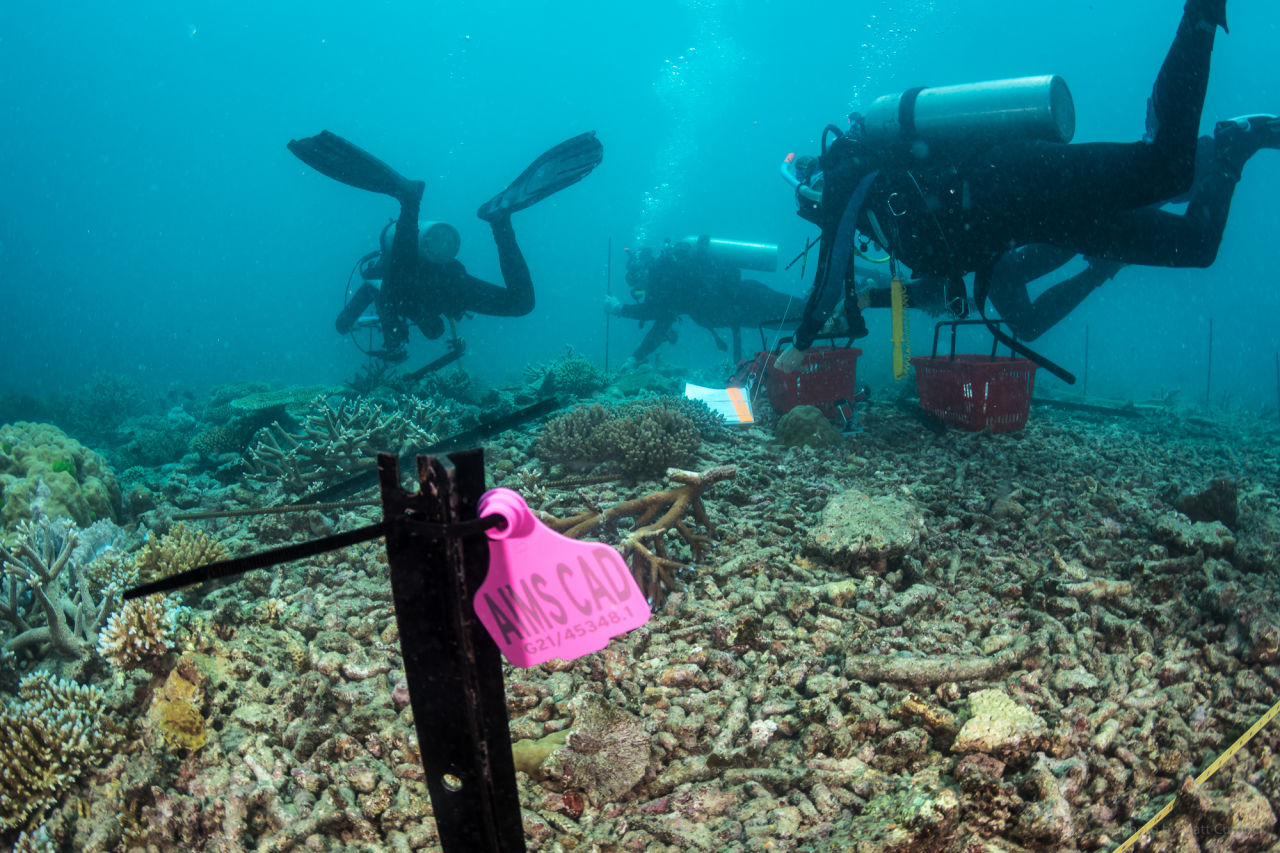Project News ·
Coral monitoring and collaboration at Moore Reef
By Abbi Scott (Hub Coordinator), Matt Curnock (CSIRO), Eric Fisher (GBR Biology), Ryan Donnelly (Reef Restoration Foundation), Carly Randall (AIMS), Bec Forster (AIMS)


“Working together is critical if we are to assist the Reef to adapt in a changing environment.”
Reef Restoration Foundation CEO Ryan Donnelly
The Cairns-Port Douglas region is home to multiple coral rehabilitation and stewardship projects supported by Traditional Owners, scientists, tourism operators and the community who are deeply committed to a healthy and resilient Reef. The Cairns-Port Douglas Reef Hub (the Hub) aims to boost collaboration to strengthen and scale ways to actively care for local reefs.
In 2022, the Hub network supported a new collaborative monitoring pilot project at Moore Reef off the coast of Cairns on Gunggandji Sea Country. The project brought together a range of partners to design and trial monitoring of a new assisted coral recovery technique. Our team included the Gunggandji Traditional Owners of the area, the Reef Restoration and Adaptation Program (RRAP) scientists from the Commonwealth Scientific and Industrial Research Organisation (CSIRO) and the Australian Institute of Marine Science (AIMS), GBR Biology, Reef Restoration Foundation and James Cook University’s TropWATER as the Reef Hub coordinator.
The new coral seeding devices engineered by AIMS are a home for young corals, which take corals collected at site and spawned in the lab, back to the reef. The aim is to improve the survival of young corals to help repopulate damaged reefs. The devices are designed to be mass producible, for rapidly replenishing reefs after a major coral loss event (e.g. cyclone, marine heatwave). As coral seeding is relatively new, several designs are being developed, tested, and improved.
Local partners were interested in learning more about the new devices, and in deepening their understanding of coral recruitment patterns. AIMS and CSIRO researchers were keen to apply local knowledge and skills to tailor how devices were deployed now and in the future. During our training days at Moore Reef, AIMS taught us how to deploy and monitor the devices. We also trialled a survey to better understand substrate suitability for coral recruitment.
Through the pilot we engaged with the Traditional Owners of Moore Reef to learn about sea country values and collect information with Rangers and community members. We undertook an information session in community about this work and Traditional Owners participated in the training day at Moore Reef to help shape the design of the project and build new skills.

Reef Magic pontoon

Sunlover reef pontoon
After the initial training and development phase, a new opportunity to trial devices was identified. AIMS worked with GBR Biology at the Reef Magic Pontoon and with Reef Restoration Foundation at the Sunlover pontoon on Moore Reef to design an additional experiment. It is evaluating the viability of newly engineered coral seeding devices.
As part of this project, we have deployed the devices with recently settled baby corals (spawned in December 2022) around the pontoons to understand how effective they are in rubble habitats. Local partners will be monitoring this experiment and collecting data over the coming year to help inform decisions about future deployment activities, including CSIRO learning about Reef visitor’s perceptions of the devices when they visit the Reef.
“There are now several different coral restoration trials underway at Moore Reef, each suited for different purposes. One of the more challenging habitats to restore are the rubble fields, caused by cyclones. Coral rubble can persist for years, and its continual movement prevents the establishment of new corals.
Some of the new devices at Moore Reef are designed to overcome this problem, helping to stabilise the substrate and allowing corals to return,” Director of GBR Biology Eric Fisher said.

Top left: Team from AIMS, Reef Restoration Foundation and James Cook University. Top right: Team briefing. Bottom left: aerial view of divers. Bottom right: divers installing devices.
“RRAP’s aim is to develop and test these devices using different deployment methods in partnership with the local community, so that we are all prepared in the event that a major replenishment of reefs becomes required. We need to do this in a strategic way, using the most suitable devices and methods for a given location, habitat type, and species. Local partners are playing a key role in this experiment, and their involvement will continue to be essential," explains AIMS Senior Research Scientist Dr Carly Randall.
Partners will continue monitoring these plots at Moore Reef tourist pontoons throughout 2023. These efforts will help understand how such devices can be used at large scales to restore damaged reefs in the future.
This research contributes to a growing body of international study and complements other ongoing work at Moore Reef being carried out by partners. The project has been a great opportunity for local partners to apply their skills and knowledge to contribute to this study, and connect with, and learn from scientists to further build local capacity and methods for reef recovery actions.

“Local partners including the Traditional Owners bring a lot of skills and knowledge to this cutting-edge research and development, and they have a key role in building our region’s capability for future coral reef stewardship activities.”
Abbi Scott, Cairns-Port Douglas Reef Hub Coordinator

AIMS Coral seeding devisces being installed
All images courtesy of Matt Curnock.
This project is funded by the partnership between the Australian Government’s Reef Trust and the Great Barrier Reef Foundation as a collaboration led by local partners Experience Co and Reef Restoration Foundation, with input from Gunggandji Land and Sea Rangers and funding and scientific input from CSIRO and AIMS through the Reef Restoration and Adaptation Program and coordinated by the Cairns Port-Douglas Reef Hub.
#Related

Project News ·
Community at the forefront of Reef water quality protection

Project News ·


